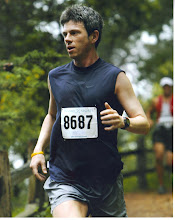
Above: our porter, after arriving at Gorak Shep
I wake exhausted, in my cold bunk in Lobuche - I had no real sleep. I had difficulty (real or anxiety-driven, it doesnt matter) getting full lungs-ful of air, during the night, and when I did eventually sleep, it was fitful & restless. Despite this, I was feeling ready for the hike ahead. Today, we were headed to Gorak Shep for a brief stop & some food, followed by another hike on to Everest Base Camp, the first of our objectives! If all went according to plan, we'd be at EBC by late morning/early afternoon.
There was no news of Bipina, following her scary departure down the mountain the previous evening. Buddha, our guide, was also still absent. Bakta, his assistant, took the lead, (nervously) giving us our pep-talk for the hike ahead, then led us off towards Gorak Shep. I found the hike very straightforward, and in a couple of hours, we were at our lodge in Gorak Shep. This would be where we'd spend the night - for now, however, I just had a breakfast of some boiled eggs, and got ready for the next hike on to Everest Base Camp. Lots of the people from Lobuche the previous night were in the lodge -- clearly, we were now on the main highway to EBC!
After a short break, we're on our way again. Out the back door of the lodge into a flat, snowy area in the bright sunlight. The going is easy initially, but soon, we're climbing up. The journey is a lot longer and more difficult than I expected. Every so often, we hear loud reports of rockslides and mini-avalanches in the distance. After about two hours, we get to the official Everest Base Camp spot. Just before arrival, somebody picks up a bone that was lying next to the path -- after a bit of consultation, Bakta decides it's a human arm- or leg- bone. (Surely, a climber's bone, thrown up by the relentless glacier.) After an awkward moment, we drop the bone, and shuffle on to the EBC site - a very real reminder of the reality of the Everest climb.
There are lots of people milling about -- including lots of people we recognize from the lodge on the way up. There's a makeshift sign nearby announcing Everest Base Camp. (Nothing official - it looks like it was carted up by some previous trekkers.) Nevertheless, we get some group shots on front of it, as well as some more dramatic photos with the blue of the Khumbu Ice-fall behind us.
There are no signs of any expedition in progress - no tents, porters or climbers - none of the bustle I had expected from watching various TV documentaries and reading books on the subject. We discovered later that a "real" base camp was being set up about 40 minutes further walk along the side of the glacier (in addition - the climbing season was just beginning - no expeditions were in place yet, and porters were just beginning to cart up the huge amount of provisions required for a climb.)
Something of an anti-climax, I have to say. Soon enough, we start our walk back down to Gorak Shep, and make some room for the groups of trekkers still making their way up. Back at the lodge, we settle in for the evening, after a fairly difficult day. Then, to cap off an unusual day, Bipina and Buddha walk in. Bipina seems ok - no more signs of altitude sickness (on the surface, at least.) She apparently felt fine in Pheriche, and she persuaded Buddha to bring her back up and, astonishingly, our guide agreed! I'm flabbergasted! I cannot believe she's dumb enough to risk her life (no matter how small the real risk is) for such a trivial reason. Anil, the doctor, is there too - and he also seems very surprised and concerned. Nevertheless, Bipina stubbornly refuses to stay at lower altitude - she's taking a huge risk to get to the top of Kala Pattar in the morning, a ridiculous decision, in my opinion...
Below: macho, I am, in shorts at Everest Base Camp :)


















